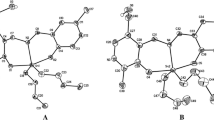Summary
The therapeutic method as advocated by Druckrey and Raabe to applicate a highly effective substance, the Stilboestrol diphosphate, as an inert “transport form” for the treatment of metastasising prostatic carcinoma has been generally approved within the last years. Recent experimental results ensured the theoretical basis of this principle. It could be proved positively that the acid phosphatases of the prostate separate the stiboestrol from the stilboestrol diphosphate.
Own research was undertaken to solve the problem whether N-Oxide-Mustard too has to be considered as an inert „transport form” of an „active form” arising in the body. Here we studied the chemical transformation of N-Oxide-Mustard comparing with N-Mustard in water, a solution of bicarbonate, serum and ascites fluid (Yoshida ascites tumor of the rat). Characteristic differences were seen between the two substances, in particular when considering the temperature of the chemical reactions. Knowing the temporal progress, selective biological trials could be carried out in order to characterize closely the various intermediate products pharmacologically.
Similar content being viewed by others
Literatur
Aiko, J., J. Owari and M. Torigoe: Nitrogen Mustard N-Oxide and its effect on the Yoshida sarcoma. J. Pharmaceut. Soc. Jap. 72, 1297 (1952).
Arnold, H., u. J. Venjakob: Formaldehyd-Abbau von Bis-(β-chloräthyl)-methyl-amin-N-oxyd. Arzneimittel-Forsch. 5, 722 (1955).
Arnold, H., u. N. Brock: Beitrag zum Wirkmechanismus von N-Oxyd-Lost. Arzneimittel-Forsch. (im Druck).
Brandes, D., u. G. H. Bourne: Stilboestrol phosphate and prostatic carcinoma. Lancet 1955 I, 481.
Brock, N.: Chemotherapie in der Chirurgie. Zweites Freiburger Symposium über Grundlagen und Praxis chemischer Tumorbehandlung, 17.–19. Juli 1953, S. 266.
Budniok, R., G. Stoll u. G. Altvater: Organspezifische Chemotherapie des Prostata-Carcinoms. Dtsch. med. Wschr. 1955, 143.
Carow, R.: Erfahrungen mit “ST 52-ASTA” bei der Behandlung des Prostatacarcinoms. Z. Urol. 47, 81 (1954).
Clarke, F. E.: Determination of chloride in water. Anal. Chemistry 22, 553 (1950).
Cottier, P., R. Leupold u. W. Scheitlin: Die hämorrhagische Diathese bei Prostatacarcinom und ihre Behandlung. Schweiz. med. Wschr. 1955, 781.
Druckrey, H.: Pharmacological bases of cancer chemotherapy. Simposio sulgi antimitotici Sanremo 1955.
Druckrey, H.: Schriftliche Mitteilung.
Druckrey, H., P. Danneberg u. D. Schmähl: Mitosegiftwirkung von Oestrogenen. Naturwiss. 39, 381 (1952).
Druckrey, H. u. S. Raabe: Organspezifische Chemotherapie des Krebs (Prostatacarcinom). Klin. Wschr. 1952, 882.
Druckrey, H., D. Schmähl, P. Danneberg, K. Kaiser, H. A. Nieper, H. W. Lo u. R. Mecke: Vergleichende Prüfung der chemotherapeutischen Wirkung von N-Oxyd-Lost und anderen alkylierenden Substanzen auf Tumoren von Ratten. Arzneimittel-Forsch. 6, 539 (1956).
Eufinger, H.: Die endokrine Behandlung bös-und gutartiger Prostataleiden. Münch. med. Wschr. 1953, 1368.
Flocks, R. H., H. Marberger, B. J. Begley u. L. J. Prendergast: Prostatic carcinoma: Treatment of advanced cases with intravenous Diethylstilbestrol diphosphate. J. of Urol. 74, 549 (1955).
Frajola, W. J., J. Mushin and J. N. Taylor: Diethylstilbestrol diphosphate for intravenous tumor specific chemotherapy of carcinoma of the prostate. Vortr. 128. Kongr. der Amer. Chem. Ges., Minneapolis 15. Sept. 1955.
Golumbic, C., J. S. Fruton and M. Bergmann: Chemical reactions of the nitrogen mustard gases. J. of Org. Chem. 11, 518 (1946).
Haddow, A., G. A. R. Kon and W. C. J. Ross: Effects upon tumours of various haloalkylarylamines. Nature (Lond.) 162, 824 (1948).
Hasche-Klünder, R. u. A. Gaca: Neue Wege zur Behandlung des Prostatacarcinoms. Med. Klin. 1955, 2032.
Hasche-Klünder, R., and H. Wilmanns: Chemotherapeutic aspects in the treatment of prostatic cancer. Vortr. Brit. Urol. Kongr. Liverpool, 28.–30. Juni 1956.
Hebborn, P. and F. J. Danielli, Selectivity of enzyme-activated nitrogen mustards. Nature (Lond.) 177, 25 (1956).
Huggins, C. B., and C. V. Hodges: Studies on prostatic cancer. Cancer Res. 1, 293 (1941).
Ishidate, M., et Y. Sakurai: Nitrogen Mustard N-oxides as tumor-growth retarding agent. 15. Internat. Pharmaceut. Assoc. Paris 1953.
Ishidate, M., K. Kobayashi, Y. Sakurai and T. Yoshida: Experimental studies on chemotherapy of malignant growth employing Yoshida sarcoma animals. Proc. Jap. Acad. 27, 493 (1951).
Knipper, W.: Prostata-Carcinom, Diagnose und Behandlung. In: Die moderne Chirurgie, Bd. 1. 5. Liefg. 1955.
Meyer, W.: Die Bedeutung der Serum-Phosphatasen für die Diagnose und Therapie des metastasierenden Prostata-Carcinoms. Die Medizinische 43, 1514 (1955).
Nash, T.: The colorimetric estimation of formaldehyde by means of the Hantzsch reaction. Biochemic. J. 55, 416 (1953).
Pfeiffer, H.: Klinische Erfahrungen mit Diäthylstilboestrol-diphosphat beim Prostatacarcinom. Wien. med. Wschr. 1955, 480.
Prigge, R., u. W. Schäfer: Methoden der Wertbemessung biologisch wirksamer Substanzen. Arch. exper. Path. u. Pharmakol. 191, 281 (1939).
Rockstroh, H.: Erfahrung bei der Behandlung des metastasierenden Prostatacarcinoms mit Honvan (“ST 52-ASTA”). Z. Urol. 48, 720 (1955).
Ross, W. C. J.: The chemistry of cytotoxic alkylating agents. Adv. Cancer Res. 1, 397 (1953).
Schäfer, W.: Zur konservativen Behandlung des Prostatacarcinoms mit organspezifischer Chemotherapie. Dtsch. med. Wschr. 1954, 221.
Schmähl, D. u. H. Druckrey: Beiträge zum Wirkungsmechanismus von N-Oxyd-Lost. Naturwiss. 43, 199 (1956).
Siegenthaler, W.: Der heutige Stand der Chemotherapie maligner Tumoren. Schweiz. med. Wschr. 1956, 899.
Warnecke, C. E.: Gezielte cytostatische Therapie des Prostata-Carcinoms. Bruns' Beitr. 190, 341 (1955).
Wilmanns, H.: Gezielte, organspezifische Chemotherapie beim Prostata-Carcinom. Medizinische 1, 17 (1954).
Author information
Authors and Affiliations
Additional information
Mit 10 Textabbildungen
Vortrag auf der Berliner Medizinischen Gesellschaft am 16. 1. 1957.
Rights and permissions
About this article
Cite this article
Brock, N. Transport-und Wirkform als chemotherapeutisches Prinzip in der Tumortherapie. Z Krebs-forsch 62, 9–24 (1957). https://doi.org/10.1007/BF00524216
Received:
Issue Date:
DOI: https://doi.org/10.1007/BF00524216




